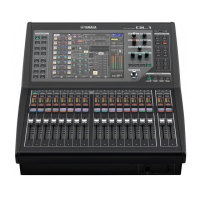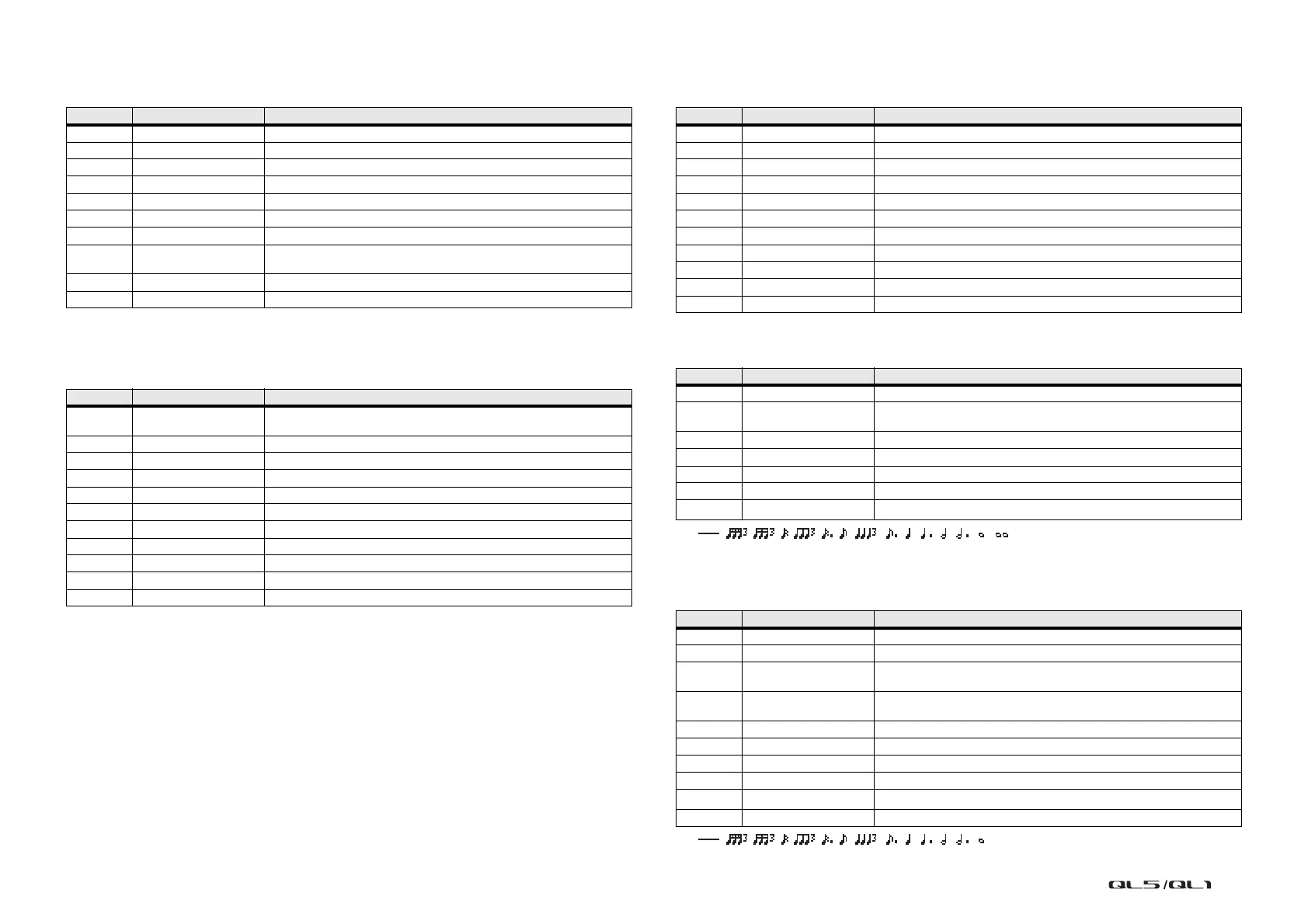Data List
9
STEREO REVERB
Two input, two output stereo reverb.
EARLY REF.
One input, two output early reflections.
GATE REVERB, REVERSE GATE
One input, two output early reflections with gate, and early reflections with reverse gate.
MONO DELAY
One input, one output basic repeat delay.
STEREO DELAY
Two input, two output basic stereo delay.
Parameter Range Description
REV TIME 0.3–99.0 s Reverb time
REV TYPE Hall, Room, Stage, Plate Reverb type
INI. DLY 0.0–100.0 ms Initial delay before reverb begins
HI. RATIO 0.1–1.0 High-frequency reverb time ratio
LO. RATIO 0.1–2.4 Low-frequency reverb time ratio
DIFF. 0–10 Reverb diffusion (left–right reverb spread)
DENSITY 0–100% Reverb density
E/R BAL. 0–100%
Balance of early reflections and reverb
(0% = all reverb, 100% = all early reflections)
HPF THRU, 21.2 Hz–8.00 kHz High-pass filter cutoff frequency
LPF 50.0 Hz–16.0 kHz, THRU Low-pass filter cutoff frequency
Parameter Range Description
TYPE
S-Hall, L-Hall, Random,
Revers, Plate, Spring
Type of early reflection simulation
ROOMSIZE 0.1–20.0 Reflection spacing
LIVENESS 0–10 Early reflections decay characteristics (0 = dead, 10 = live)
INI. DLY 0.0–500.0 ms Initial delay before reverb begins
DIFF. 0–10 Reflection diffusion (left–right reflection spread)
DENSITY 0–100% Reflection density
ER NUM. 1–19 Number of early reflections
FB GAIN –99 to +99% Feedback gain
HI. RATIO 0.1–1.0 High-frequency feedback ratio
HPF THRU, 21.2 Hz–8.00 kHz High-pass filter cutoff frequency
LPF 50.0 Hz–16.0 kHz, THRU Low-pass filter cutoff frequency
Parameter Range Description
TYPE Type-A, Type-B Type of early reflection simulation
ROOMSIZE 0.1–20.0 Reflection spacing
LIVENESS 0–10 Early reflections decay characteristics (0 = dead, 10 = live)
INI. DLY 0.0–500.0 ms Initial delay before reverb begins
DIFF. 0–10 Reflection diffusion (left–right reflection spread)
DENSITY 0–100% Reflection density
HI. RATIO 0.1–1.0 High-frequency feedback ratio
ER NUM. 1–19 Number of early reflections
FB GAIN –99 to +99% Feedback gain
HPF THRU, 21.2 Hz–8.00 kHz High-pass filter cutoff frequency
LPF 50.0 Hz–16.0 kHz, THRU Low-pass filter cutoff frequency
Parameter Range Description
DELAY 0.0–2730.0 ms Delay time
FB. GAIN –99 to +99%
Feedback gain (plus values for normal-phase feedback, minus values for
reverse-phase feedback)
HI. RATIO 0.1–1.0 High-frequency feedback ratio
HPF THRU, 21.2 Hz–8.00 kHz High-pass filter cutoff frequency
LPF 50.0 Hz–16.0 kHz, THRU Low-pass filter cutoff frequency
SYNC OFF/ON Tempo parameter sync on/off
NOTE
*1
*1. (Maximum value depends on the tempo
setting)
Used in conjunction with TEMPO to determine DELAY
Parameter Range Description
DELAY L 0.0–1350.0 ms Left channel delay time
DELAY R 0.0–1350.0 ms Right channel delay time
FB. G L –99 to +99%
Left channel feedback (plus values for normal-phase feedback, minus
values for reverse-phase feedback)
FB. G R –99 to +99%
Right channel feedback (plus values for normal-phase feedback, minus
values for reverse-phase feedback)
HI. RATIO 0.1–1.0 High-frequency feedback ratio
HPF THRU, 21.2 Hz–8.00 kHz High-pass filter cutoff frequency
LPF 50.0 Hz–16.0 kHz, THRU Low-pass filter cutoff frequency
SYNC OFF/ON Tempo parameter sync on/off
NOTE L
*1
*1. (Maximum value depends on the tempo setting)
Used in conjunction with TEMPO to determine left channel DELAY
NOTE R
*1
Used in conjunction with TEMPO to determine right channel DELAY

